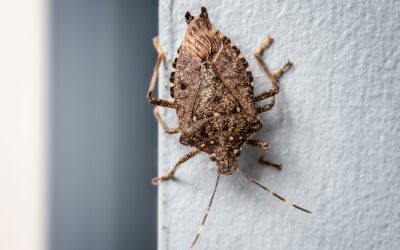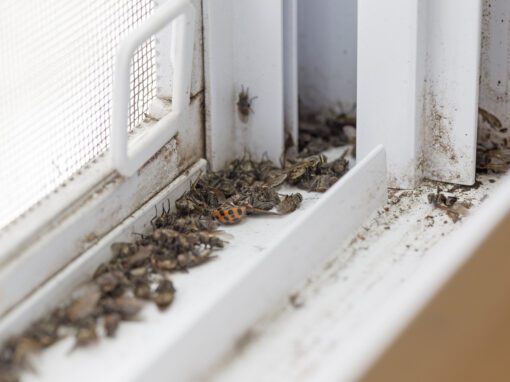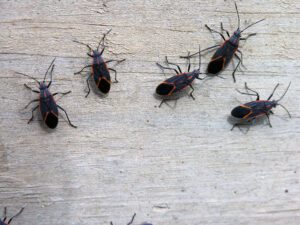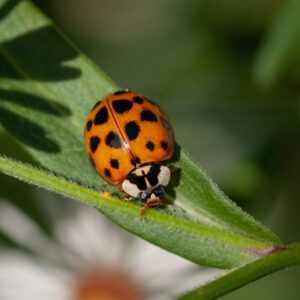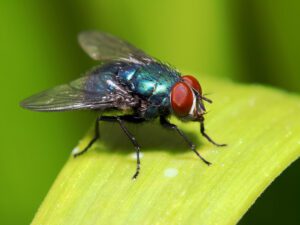This is the time of year we talk about group of insects we collectively refer to as ‘Fall Invaders’ or ‘Overwintering Pests.’ They survive cold weather by hibernating in the void spaces of structures, including homes, factories, distribution centers, etc. These insects are attracted to these structures in search of an ideal warm resting site to pass the winter. You will usually see them on the west and south walls of the buildings, which is where the sun hits the strongest.
Where do stink bugs come from?
Stink bugs, boxelder bugs, asian beetles and a few other insects in this group tend to make their presence known mostly in the fall. This annoying migration is triggered primarily by shortening daylight hours and cooler temperatures. Crops in fields are harvested, causing massive displacement. These insects will fly to the nearest structure to seek refuge from the elements as temperatures drop. Normally, it is only the adult stage of these insects that is found indoors. Once inside, they slow down their metabolism, minimize other bodily functions, and hunker down to wait for the arrival of spring and warmer days.
How many is too many?
A few fall invaders may be just a nuisance, but in larger numbers, they can exceed nuisance status, especially in sensitive accounts ( e.g. food production facilities, health care facilities, day care centers). They can stain surfaces and create odors in addition to being a contamination threat.
Stink bugs are notorious for their distinctive defense mechanism – a pungent odor that they emit when threatened or crushed. In this blog, we’ll dive into the intriguing world of stink bugs, their behavior, and how to avoid a stink bug infestation.
What is a stink bug?
The stink bug’s name stems from the foul-smelling liquid they release when feeling threatened, a distinctive feature that has earned them their notorious reputation. Stink bugs are typically shield-shaped insects. The species we see most frequently is the brown marmorated stink bug as shown in the image above.
Stink bugs primarily consume plant juices from a wide variety of crops, ornamental plants, and wild vegetation. While they usually don’t cause significant damage individually, their populations can explode under favorable conditions, causing considerable harm to crops.
One of the most intriguing aspects of stink bugs is their defense mechanism. When threatened or squashed, they emit a foul-smelling liquid from specialized glands on their thorax. This odor acts as a deterrent to predators, often making them think twice before considering stink bugs as a potential meal. The odor is reminiscent of rotten cilantro, or a very pungent earthy smell.
How to avoid stink bugs
Preventing a stink bug infestation in the very beginning of September is key to avoiding the hassle of dealing with these pests later on. Here are some preventive measures you can take to keep stink bugs away from your home and garden:
1. Seal Entry Points:
Inspect your home for gaps, cracks, and openings in doors, windows, vents, and screens. Seal these entry points to prevent stink bugs from getting indoors. Ensure that screens on doors and windows are in good condition and free from holes or tears that stink bugs could use as entry points.
2. Prune and Trim Plants:
Trim trees and shrubs near your home to eliminate potential pathways for stink bugs to access your house. Keep branches away from walls and roofs. Keep your garden well-maintained by removing weeds, dead plants, and debris, as these can provide hiding places for stink bugs.
3. Remove Attractants:
Stink bugs are drawn to food sources. Keep your kitchen and dining areas clean, and store food in airtight containers. Dispose of food waste in sealed trash cans both indoors and outdoors to reduce potential attractants for stink bugs. Stink bugs can also be attracted to the odors coming from trash. Make sure outdoor trash cans are tightly sealed.
Remember that stink bugs can be persistent, and it might take a combination of these preventive measures to effectively keep them at bay. Regular vigilance and prevention maintenance are key to avoiding stink bug infestations and the subsequent hassle of dealing with them.
How to treat for stink bugs
Getting rid of stink bugs can be a challenging task, especially during their peak seasons but it helps to know a guy! *wink wink*. If you’re dealing with a severe stink bug infestation that’s impacting your home or garden, consider hiring a professional pest management expert. Contact us so we can assess the situation and implement effective treatments for long-term protection. Our Healthy Home Maintenance Plan controls stink bugs and other overwintering pests!
Other overwintering pests we can help prevent
Boxelder Bugs
Boxelder bugs are small insects that are commonly found in and around boxelder trees, which are their main food source. They are known for their distinct appearance and behaviors that often lead them to come into contact with humans, especially during certain times of the year. During warmer months, they feed on the leaves, flowers, and seeds of these trees. However, as the weather cools down, boxelder bugs seek shelter to survive the winter. This is when they often become nuisances to humans.
Asian lady beetles
Asian lady beetles, also known as multicolored Asian lady beetles are small insects originally native to Asia. These beetles were introduced to other parts of the world, including North America and Europe, as a form of biological pest control. Like box elder bugs and cluster flies, Asian beetles congregate on the sunny south and west walls of buildings in early autumn, attracted to the warmth. They crawl into cracks and crevices on the outside of buildings and stay there for the winter out of the colder elements. On warm days, they wake up and emerge to bask in the sun.
Cluster flies
Cluster flies are a type of large fly that can become a nuisance, especially in the autumn and winter months. These flies are known for their habit of congregating in large numbers, often seeking shelter in homes and buildings to escape the colder weather. As temperatures drop, cluster flies seek warmth and shelter, leading them to enter homes and buildings through gaps, cracks, and openings. They often gather in clusters on walls, windows, and other surfaces exposed to sunlight. They are not very active during this time and may move lethargically.
Before they crawl up under the siding to seek shelter over the winter, get a protective barrier on the exterior of your home or business now before crops are harvested and these pests become displaced!
Insect Displacement: Balance of Humans and Nature
The balance between humans and nature is a complex intersection that involves numerous species and ecosystems. When considering the role of stink bugs and insect displacement in this balance, it’s important to examine both the natural ecological context and the influence of human activities.
1. Ecological Balance:
In their natural habitats, stink bugs serve as both predators and prey. They contribute to nutrient cycling and play a role in the food chain, serving as a food source for various predators such as birds, spiders, and other insects. As predators, they help control the populations of certain pests. When stink bugs are introduced to new environments, especially as invasive species, they can disrupt these natural balances. For instance, the brown marmorated stink bug, an invasive species in some regions, can multiply rapidly and outcompete native species for resources. This disrupts the native ecosystem, potentially leading to declines in native insect populations and shifts in predator-prey relationships.
2. Human Activities and Insect Displacement:
Human activities, such as agriculture and urbanization, can influence the balance between stink bugs and other insects:
- Agriculture: Stink bugs can be both pests and beneficial insects in agricultural settings. When stink bug populations surge, they can damage crops, leading to economic losses for farmers. This can disrupt the balance of pest control mechanisms in ecosystems, leading to increased pesticide use to counter the damage.
- Urbanization: Stink bugs can become urban pests when they seek shelter indoors during the colder months. This human-insect interaction can disrupt the balance between stink bugs and their natural predators, as well as causing inconvenience to humans.
In essence, the balance between humans and nature, when it comes to stink bugs and insect displacement, involves acknowledging the interconnectedness of ecosystems and taking responsible actions to minimize negative impacts. By promoting sustainable agricultural practices, we can work toward a harmonious coexistence with other insects while keeping you protected and maintaining the delicate balance of our natural world.
Prevention is Key
Stink bugs might be small insects, but their presence has had a significant impact on agriculture and ecosystems. Remember that stink bug control is an ongoing process, especially during their active seasons. Combining multiple strategies can yield better results.


